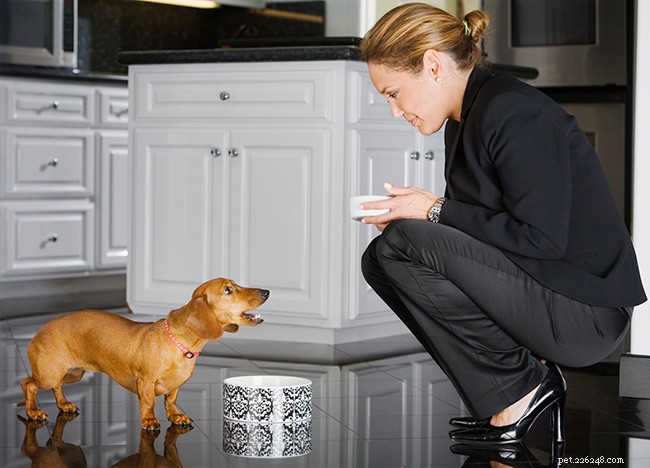
Quasi tutti i cani abbaiano. È una delle loro forme primarie di comunicazione vocale ed è stata utile nella loro evoluzione e persino nel loro ruolo di moderni compagni di casa, come quando ti avvertono del pericolo percepito o hanno bisogno di essere lasciati andare al vasino.
È irragionevole aspettarsi che un cane non abbai mai, ma quando quell'abbaiare diventa eccessivo o fastidioso per gli altri membri della famiglia o per i vicini, è tempo di agire per frenarlo. Se l'abbaiare eccessivo è un problema nella tua casa, il primo passo è capire perché il tuo cane abbaia così tanto.
I cani abbaiano per molte ragioni e possono significare cose diverse a seconda della situazione.
I cani abbaiano a:
Ecco i dettagli sui diversi tipi di abbaiare e su come affrontare quelli che necessitano di azione:
I cani possono abbaiare per attirare la tua attenzione. Stanno dicendo:"Ehi, guardami", gioca con me o accarezzami. Il comportamento del cane in cerca di attenzione è comune e si sviluppa come abilità di sopravvivenza quando sono cuccioli che si affidano totalmente alle cure della madre.
Non riconoscere affatto il tuo cane, il che significa non guardarlo, parlargli o pronunciare il suo nome. Se li riconosci, incoraggerai il comportamento, senza volerlo, poiché il tuo cane avrà successo nell'attirare la tua attenzione. L'opzione migliore è semplicemente uscire dalla stanza e chiudere la porta dietro di te in modo che non possano seguirti. Rimani fuori dalla stanza per due o tre minuti e, quando torni, non prestare loro attenzione per qualche minuto.
Potrebbero essere necessarie un paio di settimane, o anche di più, per interrompere il tuo cane da questa tattica di ricerca dell'attenzione, soprattutto se ha avuto successo per molto tempo. Sii paziente e coerente e il tuo cane imparerà che abbaiare non è più un modo efficace per attirare l'attenzione.
Quando il tuo cane abbaia a qualcuno che passa davanti a casa tua o in cortile, ti avverte di quella che percepisce come una potenziale minaccia. Non importa se la consideri una minaccia, il tuo cane agirà sempre secondo il suo istinto per proteggere la sua famiglia. Invece di sentirti frustrato quando abbaiano, cerca di capire che stanno dicendo:"Pericolo, pericolo!"
Se affronti il loro abbaiare di allerta con frustrazione, aumenterà solo la loro convinzione che devono continuare ad abbaiare mentre trasmetti ansia. È importante rispondere con calma e con la consapevolezza che il tuo cane è veramente stressato e sta cercando di fare il suo lavoro come membro della famiglia per aiutarti a proteggerti.

1. Dopo il primo abbaiare, dì "Grazie" e usa il nome del tuo cane, in modo che sappiano che stai rispondendo a loro. È fondamentale rispondere usando queste parole, poiché nella nostra cultura ci è stato insegnato a dire "grazie" con un tono calmo e riconoscente. Questo ti aiuta a ricordare che il tuo cane sta solo cercando di aiutare e il tuo tono è calmo, il che è particolarmente importante quando rispondi. If your dog stops barking after this, you don’t need to go to the next step.
3. Wait 30 seconds, and if your dog continues to bark, this means they don’t believe you are capable of making that decision and still feel responsible for making the danger go away. Without making a fuss, slip a leash over their head and calmly take them to another small room, preferably a bathroom or laundry room. If they are afraid of the bathroom or laundry room, use a different place for a time out. Puppy proof the room, turn on the light, and if you are concerned about your dog scratching on the door, put some cardboard or plywood in front of the door before you close it. Remove the leash and leave your dog in the room for three minutes. This gives your dog a chance to calm down and is a reminder that it’s not their job to protect you. If they are scratching, barking or whining, wait for a 10-second pause, then open the door and let them out of the room. Again, don’t give them any special attention.
If there is more than one dog in your home, and both dogs are still barking after step two, the dog who initiated the alert barking goes to a time-out. If the second dog stops after taking the first dog to his time out, you don’t need to do anything. But if the second dog continues barking, they are put in a different room for three minutes.
Your dog will ALWAYS bark to alert you of a threat; it’s in their nature. By following these three steps, your dog will understand that you are in charge and they don’t need to worry. These actions are based on how dogs think and perceive leadership, and after time they will be less intense in their barking and will stop more quickly.
With patience and consistency in your response, your dog shouldn’t escalate to the time outs.
Some dogs will bark to announce, “I need to go potty.” It’s always essential to honor your dog’s request to eliminate.
If your dog barks for this reason, try to appreciate your dog’s call for help, as they are communicating a need in the best way they know how. Calmly walk over to the door and let them out to go potty.
Dogs may not bark when they need to go. They may just stand by the door or circle, pace, whine or paw at the door. Even without barking, let them out regularly to avoid any accidents or discomfort.

While it may seem cute that your dog is ringing the dinner bell, so to speak, this behavior can be a sign of underlying stress.
If you feed your dog when they demand it, whether by barking or other attention-getting behaviors, your dog will believe that they are in charge of the food. This can lead to behavioral issues such as:
The easiest way to address this behavior is to ignore their demand to be fed. Wait until they have stopped trying to get your attention for a while, then feed them. I also recommend changing up their mealtimes by 1 ½- 2 hours. Creating a two-hour window, whenever possible, breaks the habit of your dog expecting to be fed at a particular time in your routine. Eventually, they will stop demanding to be fed, and instead of being woken up by your dog earlier than you’d like, you will be able to sleep in!

When multiple dogs live in a home, they will sometimes bark at each other to communicate that they want all of the attention. For example, one dog may be getting some affection, then another dog comes over to get attention, and the first dog warns the second dog to back off with a bark. This can be a sign of possessive behavior towards the human and must be addressed.
You must decide when affection is given, especially with multiple dogs in the home, so that one dog doesn’t monopolize your attention. If you allow one dog to push the other dog or dogs out of the way, it can lead to the other dogs feeling like they are walking on eggshells. This can lead to other behavioral issues. You should be able to call a dog over to you without either dog reacting negatively.
If your dog exhibits this behavior, it’s helpful to have a leash attached to their collar for easy access so that you can address the action quickly. Of course, you need to ensure that someone is monitoring the dog, so they don’t get tangled in the leash and hurt themselves. If the possessive dog shows signs of telling another dog to back off as you or another family member are giving them attention, they need to be immediately and calmly removed from the room. Step on the leash, don’t look at or talk to the dog, remain calm and matter-of-fact in your energy, and pick up the leash.
Then, escort the dog to the bathroom or laundry room to be separated from everyone. Turn on the light, remove the leash, and leave them alone in the room for three to five minutes. After three minutes, open up the door, put the leash on, with no acknowledgment, and let them out. If they are barking, whining, or scratching on the door, it’s crucial to wait for a 10-second break in the barking, whining or scratching, then open the door. If not, they will think they were let out because they were complaining, and that reaction will escalate.
Some dogs need to be walked on a leash back into the room with the other dogs, or they could go straight to the other dog and lunge again. Don’t drop the leash until the dog’s energy is calm and relaxed. You set the room’s tone by creating as much safety and calm energy as possible, bringing the stress level down, making it easier for the dogs to feel relaxed.
If they have separation anxiety, three minutes is adequate. You don’t want them to get stressed being separated for too long. However, if the dog is assertive and confident, they usually require four to five minutes of separation to digest the message.
The reason for separation is that dogs understand this consequence as if they were part of a pack on the street or in the wild. If they made a mistake in the pack, essentially challenging the leadership, they would be reminded that they were not in charge of making decisions. They would be shunned from the rest of the pack for a while. As they are now living in our homes, we are their pack, so this consequence makes sense to them. When done consistently, we will teach them their behavior is unacceptable.
It’s vital to ensure that you give each dog in your home attention and that they all feel included. By calling them to you for affection, you are showing them that you are in charge of when they receive attention and that one of them isn’t more important or higher ranking than the other.
This allows all of your dogs to feel comfortable and relaxed with you and in general. Remember, even for a dog who may be bullying, they are feeling stressed, or they wouldn’t be exhibiting that behavior.
Dogs can bark to show another dog that they are in charge in other ways:
For any controlling behavior like this, it’s essential that it’s addressed every time and that you don’t let the dogs work it out between them. You must always show that you are in charge and that it’s never OK for any of your dogs, no matter their age, to try to control another dog in the home.
Just like you wouldn’t let kids fight; an adult would step in to resolve the conflict. For any attempt to control another dog in the home, the dog asserting themselves should be immediately and calmly separated for a time out, as previously described.
Once the issue has been resolved, the atmosphere in the home will change:
Dogs use their voice and bark to say “throw the ball!” and to express that they are having fun.
While this is probably the best kind of barking to a pet parent, it’s important that you are in charge of the playtime, meaning that you:
Your dog is in charge of playtime if they:

The easiest way to stop this behavior is simply putting the ball or toy out of sight when you are finished playing the game.
I also recommend adding rules to the game; the more you establish that you are creating the rules for playtime, the less your dog is likely to try to make up their own rules.
For example, if you want to play fetch, ask them to ‘sit’ before you even throw the ball, requiring them to show self-control. Then as you throw it, ask them to ‘fetch’. Once they have picked it up, say, “good fetch, bring it.” If they bring it to you, then say, “good bring it, drop it.”
It’s easier to teach them to drop it, in the beginning, if you exchange the ball for a treat. Once they bring it and you have praised them, hold the treat in front of them, as you ask them to “drop it”. As soon as they drop the ball, pick it up with one hand, as you give them a treat with the other and say, “good, drop it.”
This keeps your dog’s focus on you and what you expect from them to continue playing the fetch game. If they are barking in the joy of the game, but not being demanding, keep playing.
If they start demanding that you throw it, you can walk back inside and put the ball away, ending the game if you like. Another option is to wait until they have stopped barking, then throw the ball. The goal is that you define the rules of the game.
Sarah-Anne Reed is a holistic dog trainer, and owner of Pack Dynamics, LLC ®. Her practice focuses on understanding and respecting dogs as a different species and honoring them as individual beings.
This article is copyrighted by Sarah-Anne Reed and Pack Dynamics ® LLC, and no reproduction of this article without the express permission of Sarah-Anne Reed, is permitted.
Are you someone who takes dog training seriously? Then you are a great candidate for pet insurance. Get a quote and make sure you’re covered for future injuries or illnesses.